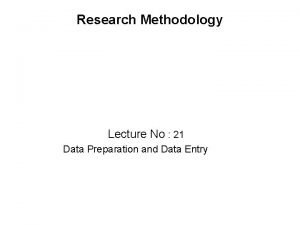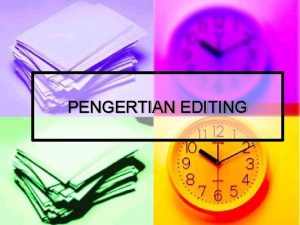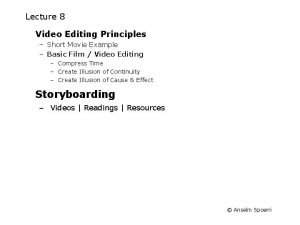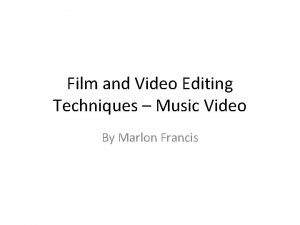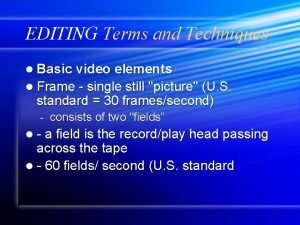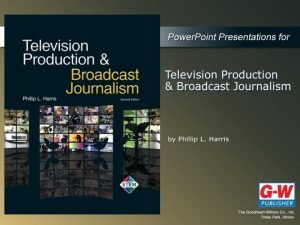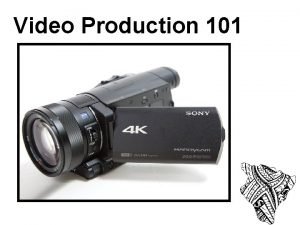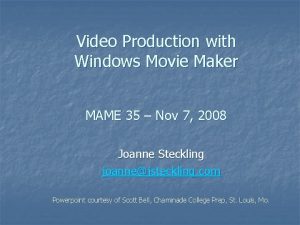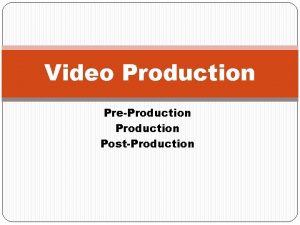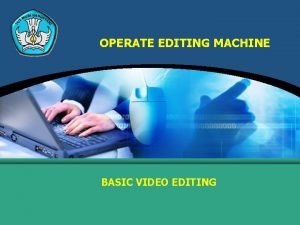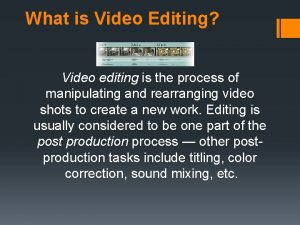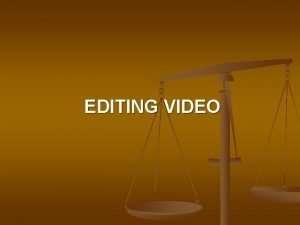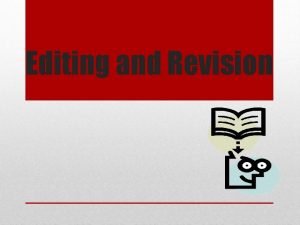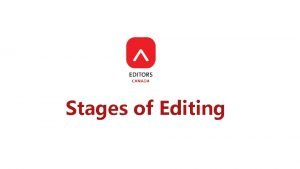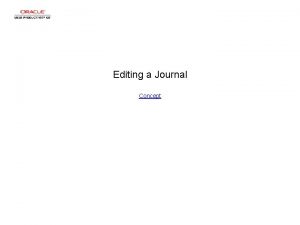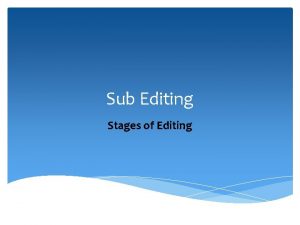Video Production Editing Video EDITING using a NonLinearEditor










- Slides: 10

Video Production Editing Video

EDITING using a Non-Linear-Editor • You will be creating non-destructive edits. Your original files remain unaltered at all times. • Your software will present the live results of your editing decisions. When you are finished, you will create a new file by clicking on ‘Export’. • You can “Export” as many variations of this self-contained final movie file in as many different formats for your intended audiences as you want.

EDITING using a Non-Linear-Editor • An efficient workflow is as follows. 1. Create a main folder. Create sub-folders for all your original video/audio/still images/effects. 2. Open Premiere. 3. Recreate the same folder structure (folders are called Bins) in Premiere. 4. Import all relevant media into their appropriate bins. 5. Save your Premiere file inside the main folder.

ROUGH-CUT EDITING 6. Play through your 1 st scene (including all takes!). 7. ROUGHLY decide where the best take should begin & ROUGHLY where it should end. 8. ROUGHLY scrub to your “In” point. Press “i” (for IN). 9. ROUGHLY scrub to your “Out” point. Press “o” (for OUT). 10. Press “, ” (for INSERT). 11. Move on to the next scene. Repeat. 12. Do NOT get fussy now. That will only waste time. 13. ROUGH-CUT your entire sequence.

RIPPLE & ROLLING EDITS 1. Watch your sequence through. If it looks good, you have spent far too much time on the rough-cut! 2. Click on your 1 st clip & press ↑. 3. Now, open the ‘Trim Window’ (Press “T”). The 2 visible images represent the end of the 1 st clip and the beginning of the next one. 4. Press the Spacebar. This loops around the edit point. Watch it a few times. Press again to stop. 5. Moving the mouse onto the Trim Window presents these options…

RIPPLE & ROLLING EDITS 6. Hovering over either clip presents the ‘Ripple Tool’. Clicking and dragging either cuts away material from that specific clip, or brings it back. 7. Hovering in the centre presents the ‘Rolling Tool’. Clicking and dragging moves the edit point. The combined length of both clips is unchanged. Straight cuts are standard. A transition should only be used if there is a reason for it.

EDITING ACTION • In action sequences, it is the visuals that tell the story and the editor has the major creative responsibility, for it is only in the process of editing that the shots acquire their significance. • Unhampered by the restrictions imposed by synchronised dialogue, the editor is able to work with great freedom. However good the director’s raw material, it is the editor who makes an action sequence either great, or just okay.

EDITING DIALOGUE • In a dialogue scene, most of the visuals form an essential counterpart to the words and the editor is constantly tied down by those words when editing the picture. • The visuals are anchored from the moment they are shot, and the editor is reduced to choosing between alternate shots and to timing the cuts for the greatest dramatic effect.

USEFUL SHORTCUTS - + to zoom in and out of the timeline resets the timeline so that all of it is visible at once i, o & , are for in point, out point & insert i, o &. are for in point, out point & overlay (use your 1 st & 2 nd finger and thumb. These 3 keys form a nice triangular shape underneath your hand) m creates a marker on your timeline (double click on one to see how useful they are) spacebar plays, ← → go backwards or forwards a single frame ↓↑ jumps backwards or forwards to the next edit point

THE GOLDEN RULE OF PRODUCTION • Remember the THE GOLDEN RULE OF PRODUCTION You can have it EXCELLENT, FAST or CHEAP-PICK ANY TWO So, choose… • You can have it excellent & cheap, but it won’t be fast! • You can have it fast & cheap, but it won’t be excellent!
 Alur proses produksi
Alur proses produksi Field editing and central editing in research
Field editing and central editing in research Linear and nonlinear editing
Linear and nonlinear editing Konsep editing
Konsep editing Video editing principles
Video editing principles Music video editing techniques
Music video editing techniques Video editing terms
Video editing terms Objectives of editing
Objectives of editing 3 phases of video production
3 phases of video production Video production maker
Video production maker Pre production planning for video film and multimedia
Pre production planning for video film and multimedia

